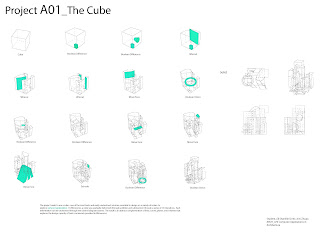Over the course of the Fall 2013 semester at the University of Maryland's School of Architecture, Planning, & Preservation, works from ARCH_470, a class focusing on computer applications within the architectural design process, will be posted for review and discussion.
Friday, December 20, 2013
Tuesday, December 3, 2013
Tuesday, November 19, 2013
Tuesday, November 5, 2013
ARCH | 470 Preliminary Night Rendering
Before Rendering: Above is sectional model created in Sketchup Make, imported and touched up in Rhinoceros 5, and rendered using V-Ray for Rhino.
After Rendering: For this latest assignment, students were tasked with beginning to render a project from their design studio. Above is a night rendering of a section model, created using Adobe Photoshop. The rendering seeks to establish a comfortable night atmosphere in a well-lit area.
Tuesday, October 15, 2013
ARCH | 470 A02 - Final Presentation
Tuesday, October 8, 2013
ARCH | 470 A02 - Part 3
Above are the three IN-PROCESS art boards for the final design of my approach to Project A02 (due Thursday, October 10 for final review). This scheme was developed after finally deciding on the site of the bus stop--the Grand Canyon in Arizona. The first board will describe the site's influence on the design behind the bus stop, the second board will explain the physical evolution of the form of the stop using the tools in Rhino, and the third board will reveal the ways in which people interact with the bus stop through a series of 8-10 diagrams.
Tuesday, October 1, 2013
ARCH | 470 A02 - Part 2
The second phase of Project A02 serves as a continuation of the formal design process. Along with continuing the idea of surface manipulation, students were also tasked with adding texture to the bus stop as a way of forming a more dynamic object that successfully interacts with the site by playing off of certain aspects of the site (i.e. sunlight, shading, etc.). Plans, elevations, axons, and a rendered drawing are provided to reveal the unique geometric properties of the proposed bus stop.
Thursday, September 26, 2013
ARCH | 470 A02 - Part 1
Exploring the surface manipulation properties of Rhino is vital in understanding how the computational aspects of the design process far exceed the what was once practiced. Architecture 470's Project A02 tasks students with the creation of a bus stop on an undetermined site. In the above three schemes sweeps, folds, and curves are manipulated to create shaded seating areas as well as potential bike stands (Scheme 3) for people patiently awaiting the bus.
Thursday, September 19, 2013
ARCH | 470 A01
The project seeks to use a cube--one of the most basic and easily understood volumes, essential to design on a variety of scales--to explore surface manipulation. In Rhinoceros, a cube was gradually deformed (using methods of addition and subtraction) giving any viewer the ability to witness the evolution of process over the series of 15 iterations. The result of this process is an abstract conglomeration of lines, planes, and volumes that explores the design capacity of basic commands made available in Rhinoceros.
Subscribe to:
Comments (Atom)
















